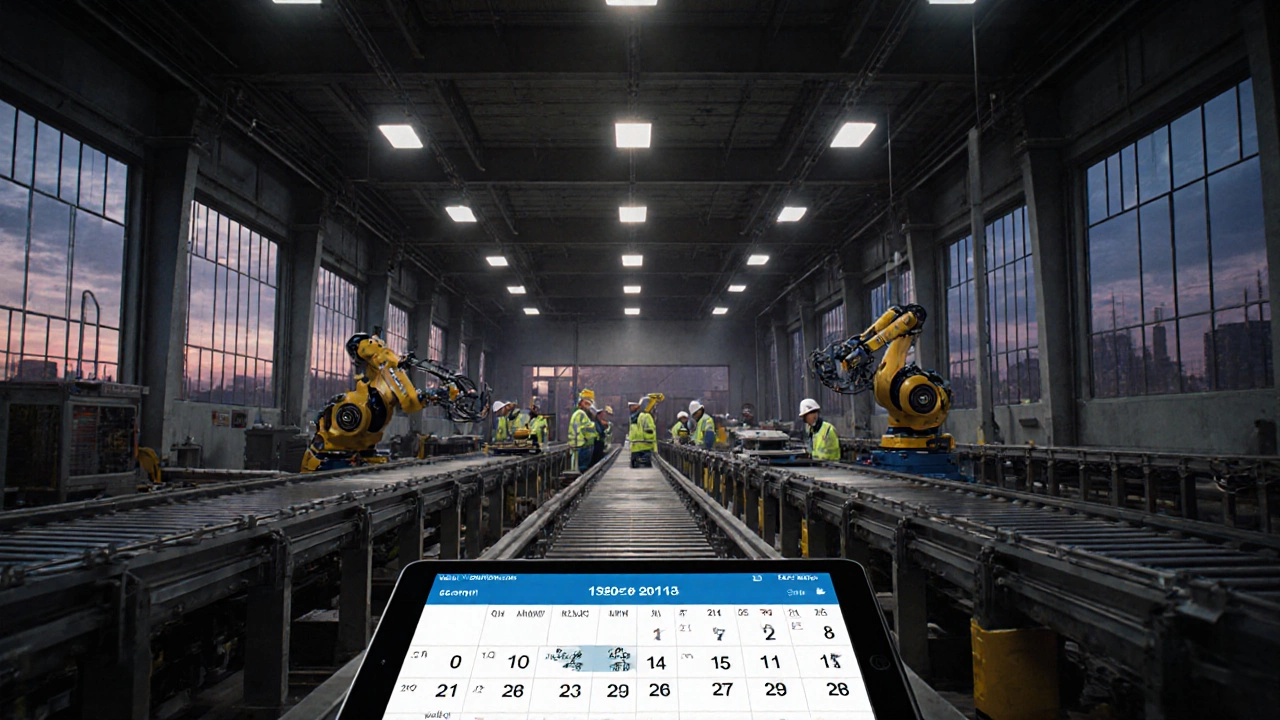Manufacturing Cost Calculator
Estimate your production costs and determine if your product meets the recommended 30% profit margin before overhead.
Dreaming of setting up a manufacturing startup but not sure where to begin? You’re not alone. Hundreds of aspiring entrepreneurs in the UK stare at the same question every year: how do I break into manufacturing without a massive budget or a long‑standing industry network? This guide walks you through the whole process - from spotting a viable product idea to securing funding, passing compliance checks, and actually turning on the production line.
Understand What Manufacturing Really Means
Manufacturing is a process of converting raw materials or components into finished goods on a commercial scale. It covers everything from a single‑room workshop slicing wooden toys to a multimillion‑pound plant assembling electric cars. Knowing the breadth of the field helps you decide which niche aligns with your skills, budget, and market demand.
Pick a Niche That Matches Your Strengths
Before you write a business plan, ask yourself three questions:
- What product can I design or improve?
- Do I have access to the required raw materials?
- Is there a clear customer need?
Common high‑growth niches in the UK for 2025 include sustainable packaging, 3‑D‑printed medical devices, and low‑carbon food processing. If you have a background in engineering, consider electronics manufacturing that focuses on printed circuit board assembly and IoT hardware. If you love crafts, small‑scale textile manufacturing like eco‑friendly fabrics or custom‑printed apparel might be the sweet spot.
Validate the Market with Real Data
Market research prevents you from building a product nobody wants. Use these steps:
- Search trade reports from the UK Government through the Department for Business and Trade for industry growth rates.
- Analyse competitor pricing on platforms like Alibaba, Made‑in‑Britain, and local trade shows.
- Run a small‑scale pilot - for instance, 100 units sold via a Kickstarter campaign - to gauge demand.
Document findings in a simple spreadsheet: target market size, average selling price, production cost per unit, and projected profit margin. Aim for at least a 30% margin before factoring overhead.
Draft a Lean Business Plan
A business plan doesn’t have to be 100 pages. Focus on five sections:
- Executive summary - one paragraph stating what you’ll make, for whom, and why it matters.
- Product description - include design sketches, bill of materials, and a prototype timeline.
- Market analysis - summarize research from the previous step.
- Operations plan - outline the location, equipment, staffing, and supply chain.
- Financials - project cash flow for the first 18 months, highlighting break‑even point.
Use Lean Manufacturing principles to keep waste low and iterate quickly. This mindset not only saves money but also impresses investors who look for disciplined cost control.

Secure Funding - Know Your Options
Funding can come from several sources. Below is a quick comparison of the most common routes for UK manufacturers.
| Source | Typical Amount | Eligibility | Time to Obtain | Pros | Cons |
|---|---|---|---|---|---|
| Self‑Funding | £5k‑£50k | Anyone | Immediate | Full control | Limited capital |
| UK Government Grants | £10k‑£250k | SMEs, innovation focus | 2‑4 months | Non‑dilutive | Competitive, reporting |
| Bank Loans | £50k‑£1M | Good credit, collateral | 1‑2 months | Predictable repayment | Interest costs |
| Equity Investors | £100k‑£2M | Scalable idea, traction | 3‑6 months | Mentorship, network | Dilution of ownership |
| Crowdfunding | £10k‑£200k | Compelling story, pre‑orders | 1‑3 months | Market validation | Fees, public disclosure |
For most first‑time founders, a blend of a small personal investment and a government grant (like the UK’s Innovate UK grant programme for advanced manufacturing) offers the fastest runway without giving away equity.
Choose the Right Location and Facility
Location impacts logistics, labor costs, and eligibility for regional incentives. Consider these factors:
- Proximity to suppliers - reduces inbound freight and lead times.
- Access to skilled labor - areas like the Midlands have a strong engineering talent pool.
- Local incentives - some councils offer property tax relief for manufacturing jobs.
If capital is tight, start in a shared manufacturing space also known as a maker‑space or fab‑lab, offering equipment on a pay‑per‑hour basis. This lets you run a pilot line without committing to a full‑size lease.
Build a Reliable Supply Chain
Raw material availability can make or break your operation. Follow these steps:
- Identify at least two qualified suppliers for each critical component.
- Negotiate terms that include minimum order quantities and lead‑time guarantees.
- Implement a simple inventory management system - even a spreadsheet can track reorder points for low‑volume runs.
Don’t overlook sustainability. Many UK buyers now require evidence of responsible sourcing, so keep documentation ready for audits.
Navigate Regulatory Compliance
Manufacturing in the UK is subject to several regulations, depending on the product:
- CE or UKCA marking - required for many hardware items sold in Europe or Great Britain.
- Food Standards Agency (FSA) approvals - essential if you’re processing consumables.
- Health and Safety at Work Act - sets standards for workplace safety, machine guarding, and employee training.
Engage a consultant early to avoid costly re‑engineering later. Most local enterprise partnerships (LEPs) offer free compliance workshops for startups.

Launch a Prototype and Iterate
Prototyping turns ideas into tangible products you can test. Choose the method that matches your budget and complexity:
- 3‑D printing - fast for plastic components and design tweaks.
- CNC machining - offers higher precision for metal parts.
- Hand‑crafted mock‑ups - useful for textile or furniture concepts.
Gather feedback from potential customers, adjust the bill of materials, and update your cost model. Each iteration should bring you closer to a design that can be manufactured at scale with the target margin.
Scale Up While Controlling Costs
Once you’ve validated demand, it’s time to move from pilot to production. Key actions include:
- Finalize the production line layout optimising workflow for minimal movement and bottlenecks.
- Negotiate bulk pricing with suppliers - volume discounts can shave 10‑15% off material costs.
- Implement a basic ERP or cloud‑based manufacturing software to track orders, inventory, and quality metrics.
Maintain a cash reserve equal to at least three months of operating expenses. Even successful startups hit hiccups - a delayed shipment, a machine breakdown, or a sudden regulatory change - and that buffer keeps the line running.
Keep Learning and Adapting
Manufacturing is never static. Join industry groups like the Institute of Mechanical Engineers (IMechE) providing networking events and technical journals. Attend trade fairs such as The Advanced Manufacturing Show in Coventry. Continuous learning helps you spot emerging technologies - think AI‑driven quality inspection or low‑energy metal 3‑D printing - that can give you a competitive edge.
Frequently Asked Questions
Do I need a large factory to start manufacturing?
No. Many successful businesses begin in a garage, a shared maker‑space, or a converted warehouse. The key is to match the scale of your production to market demand and grow the facility as sales increase.
What government support is available for new manufacturers in the UK?
Programs like Innovate UK, the Regional Growth Fund, and local enterprise partnership grants provide non‑dilutive funding, advisory services, and sometimes tax relief for equipment purchases.
How can I protect my product idea while seeking investors?
Use non‑disclosure agreements (NDAs) when sharing detailed designs, and file a provisional patent if the invention is truly novel. Investors are accustomed to confidentiality clauses.
What are the biggest pitfalls for first‑time manufacturers?
Under‑estimating production costs, ignoring regulatory requirements, and scaling too fast without cash reserves are the most common mistakes. Conduct thorough cost modelling and keep a lean, iterative approach.
Is it better to buy equipment outright or lease it?
Leasing reduces upfront capital outlay and gives flexibility to upgrade as technology evolves. Buying makes sense if the equipment has a long useful life and low depreciation.
